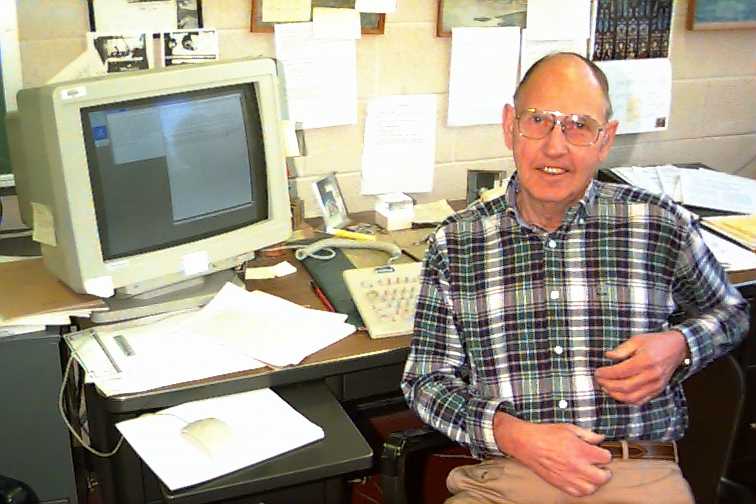
STEP CODE FACT SHEET 
1. Code Name: STEP
2. Category: VIId. Linear Stability: 3D Averaged
3. Responsible Physicist: John L. Johnson
4. Others involved in code development: G. Anania (originally), G. Rewoldt, Y. Nakamura, F. Herrnegger, M. Wakatani, K. Ichiguchi.
5. One line description: MHD equilibrium and linear stability solver for stellarators, using averaged method to reduce to 2-d problem.
6. Computer systems which code runs on: Cray, Nagoya
7. Typical running time: ~ 20 minutes per case, give or take.
9. Does this code read data files from another code? Yes, the equilibrium code reads properties of averaged fields produced by vacuum field codes developed at Oak Ridge and Kyoto. The stability code can use the equilibrium code output or is typically coupled to a code that averages the output of the VMEC code.
10. Does this code produce data files that can be read by another code? No.
11. 1-2 paragraph description of code: This modifies the tokamak equilibrium and stability PEST codes to use the "stellarator expansion" to study stellarators. This expansion reduces the 3-D problem to a 2-D one by determining the nonaxisymmetric behavior analytically in terms of the lowest-order axisymmetric functions, reducing the equilibrium problem to one of solving a generalized Grad-Shafranov equation in which an averaged helical curvature is added to the well known toroidal curvature, and reducing the linear stability problem to a simple eigenvalue problem in one independent variable. The PEST-2 code was modified to use this reduced stability formalism. The codes are fast and useful for stellarator scoping studies.
12. Similar codes to this code, and distinguishing differences: Several other codes, including TWIST (developed by V. V. Drozdov and his colleagues at Keldysh Institute), RESORM (developed by K. Ichiguchi at Kyoto and applied at NIFS), CHAFAR (developed by L. Garcia and B. A. Carreras at Oak Ridge and used in Madrid), and HERATO (developed by J. Todoroki at NIFS are all based on averaging techniques similar to the stellarator expansion. Some of these use somewhat different averaging techniques from those used in KSTEP (the name given to a version of STEP that was improved by a collaboration between members of the Kyoto University Plasma Physics Laboratory and PPPL. Two fully 3-D codes, TERPSICHORE, (developed by Troyon's group in Lausanne), and CAS3D (developed by C.~Schwab-Nuhrenberg at IPP-Garching) to determine low-n stability have been developed.
13. Journal References describing code: J. L. Johnson, K. Ichiguchi, Y. Nakamura, M. Okamoto, M. Wakatani and N. Nakajima, External Kink Modes in a Large Helical Device (LHD) Equilibrium with Self-consistent Bootstrap Current, Phys. Plasmas 6, 2513-2522 (1999). Y. Nakamura, K. Ichiguchi, M. Wakatani, and J. L. Johnson, J. Phys. Soc. Japan 58 3157-3174 (1989). G.Anania, J. L. Johnson, and K. E. Weimer, Phys. Fluids 26, 2210-2218 (1983). G. Anania and J. L. Johnson, Phys. Fluids 26, 3070-3078 (1983).
14. New code capabilities planned for next 1-2 years: Implementation of an algorithm to do the stellarator averaging in Boozer coordinates as was done by Garcia and Carreras may be done if the group at Kyoto University can find the time. As presently written the code is only useful for study of configurations with a nearly planar magnetic axis, so that it can not be applied to heliac and helias-like configurations. Augmentation for application to gap mode studies may also be incorporated. 2 STEP
15. Code users: In the past, the theory groups at PPPL, ORNL, IPP (Garching) and PPL (Kyoto). The Kyoto group is still actively applying it for some data analysis on Heliotron E and for some physics studies.
16. Present and recent applications of code: H. Zushi et al., 13th Conf. on Plasma Phys. & Controlled Nucl. Fusion Res., Washington, 1990, IAEA-CN-52/C-3-2. Y. Nakamura et al., Theory of Fusion Plasmas (Varenna, 1990) p. 677-684. Y. Nakamura et al., 12th Plasma Simulation Conference, Annapolis, 1991, paper 3-PWE-13.
17. Status of code input/output documentation. Check one: ( ) does not exist (X) incomplete (at best) ( ) exists
18. Year Code was first used and present frequency of use: 1982. Limited use being made at Kyoto University Plasma Physics Laboratory.
19. Estimate of Man-Years invested in developing code: 3
20. Catagories of usage of Code (Check all that apply): (x) application code to do analysis and prediction of experiments (x) numerical testbed of theoretical ideas ( ) physics module to be used in integrated moddelling (x) code for machine design
21. Language code is writen in: Fortran
22. Results of intercomparisons with other codes and results of validation against experiments. The equilibrium code has been verified through comparisons with both 2-D and 3-D calculations. The stability code was shown to agree well with other averaged codes, with calculations for a straight helical system using the HERA code, and to some extent with stability studies using the 3-D BETA code some time ago. An international effort to compare the major linear MHD stability codes for stellarators showed good agreement between KSTEP, TWIST, RESORM, CHAFAR, CAS3D, and TERPSICHORE. The results, in PPPL-3092 (1995), were presented in the Tenth International Workshop on Stellarators in Madrid, May, 1995 and have been submitted to the Journal of Computational Physics.